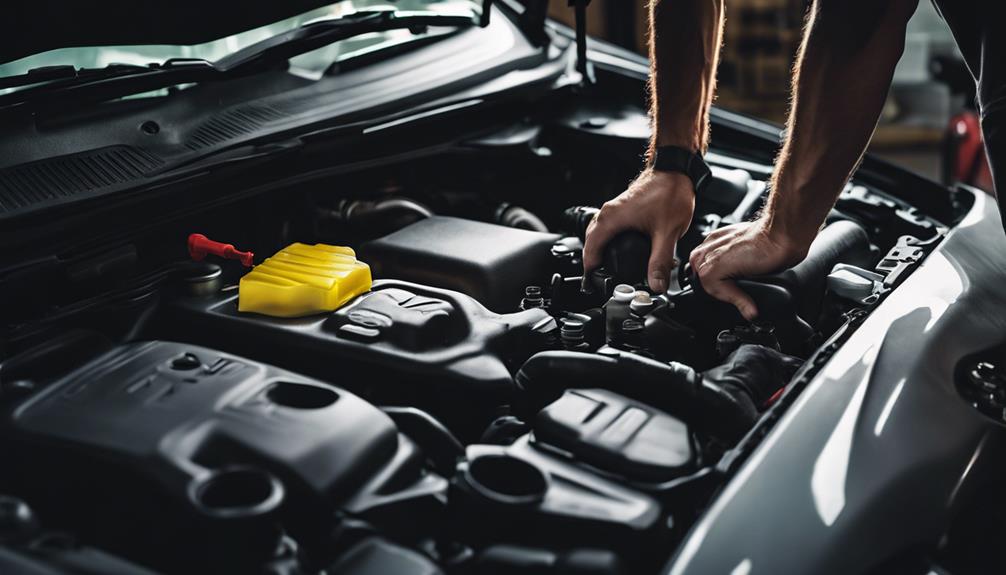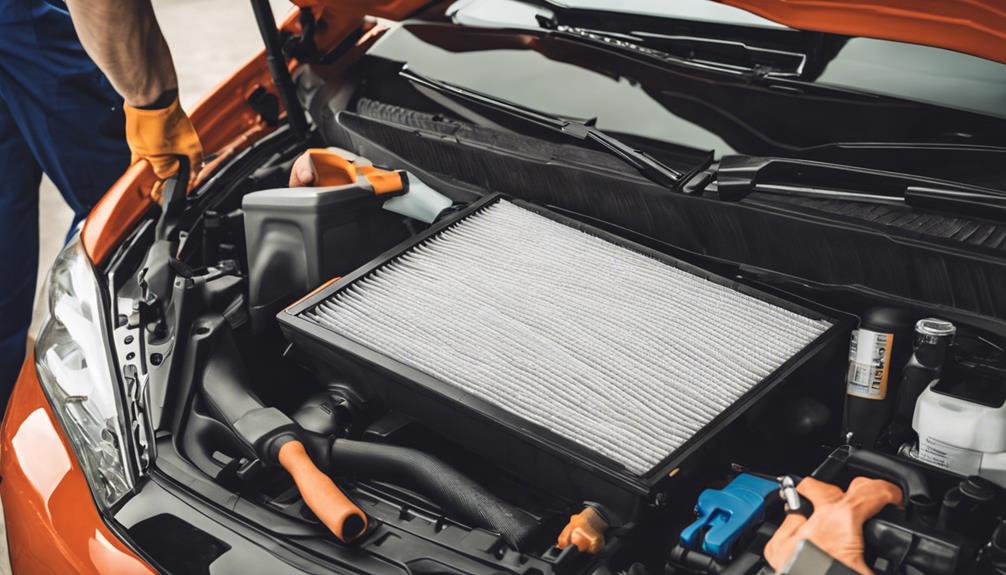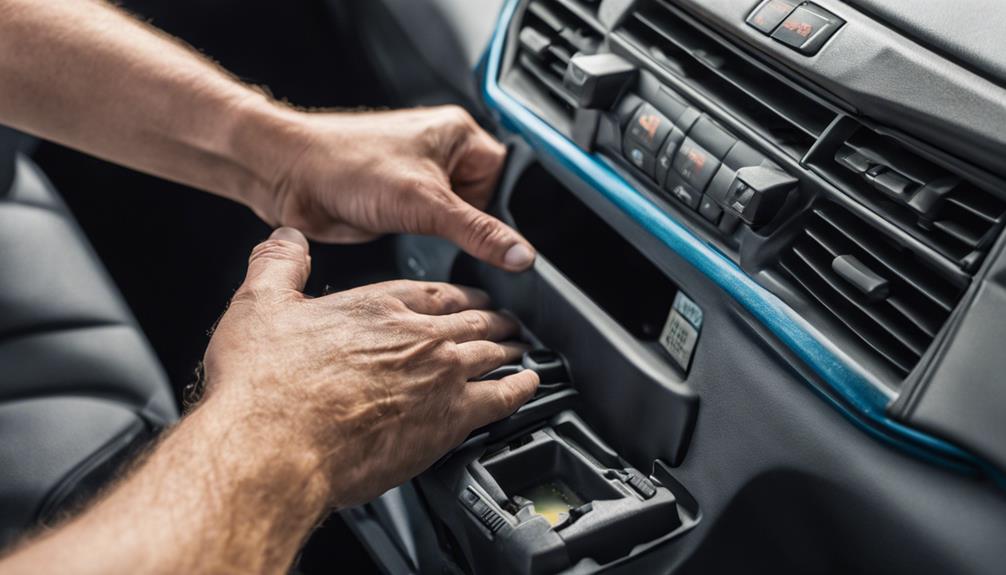To keep your RAV4 running smoothly, follow the maintenance schedule closely. At 5,000 miles, rotate your tires, check and refill fluid levels, and inspect wiper blades and brakes. At 10,000 miles, change the oil and filter, plus handle essential checks from the 5,000-mile mark. Regularly inspect your brakes for peak performance and address any squeaking or grinding noises quickly. Check engine oil, coolant, and transmission fluid levels every 5,000 miles or six months. Replace your cabin air filter every 15,000 to 30,000 miles for improved air quality. For more insights and detailed steps, continue here.
Key Takeaways
- Rotate tires and check fluid levels every 5,000 miles for even wear and optimal performance.
- Change engine oil and filter every 5,000 miles or 6 months for engine longevity.
- Inspect brake linings, drums, pads, and discs regularly to ensure safe braking.
- Replace cabin air filter every 15,000 to 30,000 miles for clean air and HVAC efficiency.
- Use high-quality filters, preferably genuine Toyota, for peak engine performance and efficiency.
Maintenance at 5,000 Miles
At 5,000 miles, you should rotate your RAV4's tires to promote even wear. This simple step guarantees that your tires last longer and perform better. Not only does this save money in the long run, but it also gives you better control over your vehicle, especially in challenging driving conditions.
Next, check and refill all fluid levels as needed. This includes oil, coolant, brake fluid, and windshield washer fluid. Keeping these fluids at their best levels ensures your RAV4 runs smoothly and reduces the risk of unexpected breakdowns. You'll have peace of mind knowing your vehicle is operating at its peak.
Inspect your wiper blades for any signs of cracking or damage. Effective wipers are essential for maintaining visibility in all weather conditions. Don't wait for a rainy day to discover they're not up to standards—replace them if necessary.
Lastly, perform a visual inspection of your brakes. Ensuring your brakes function at their best is non-negotiable for safety. Look for any signs of wear or damage and address them promptly.
Maintenance at 10,000 Miles

When your RAV4 hits 10,000 miles, it's important to change the oil and replace the oil filter to keep the engine in top shape. This step guarantees your engine runs smoothly and efficiently, preventing unnecessary wear and tear. Don't overlook the other tasks included at this interval, which encompass all the essential checks and services from the 5,000-mile maintenance.
Following Toyota's recommendations at 10,000 miles is essential for maintaining your RAV4's performance and efficiency. Regular oil changes are essential for the health and longevity of your vehicle's engine. Fresh oil lubricates the engine's moving parts, reducing friction and preventing overheating. Replacing the oil filter ensures that any contaminants are effectively removed, allowing the oil to do its job without obstruction.
Essential Oil Changes
To keep your RAV4 running smoothly, change the engine oil and filter every 5,000 miles or 6 months. Make sure you use the oil type recommended in your owner's manual for best performance. If you're up for a DIY oil change, follow the necessary steps to guarantee everything is done correctly.
Frequency of Changes
Changing the oil in your RAV4 every 5,000 miles or six months is vital for maintaining engine health and performance. Sticking to this schedule guarantees your engine stays lubricated, reducing friction and preventing wear and tear. When you follow the recommended oil change intervals, you're not just keeping your engine clean, you're also avoiding potentially costly repairs down the line.
Regular oil changes are a routine maintenance task that you shouldn't overlook. Neglecting them can lead to sludge build-up, decreased fuel efficiency, and even engine failure. Your RAV4's engine works hard every time you drive, and clean oil is essential for its longevity. Ignoring the oil change schedule can result in serious engine issues that could have been easily avoided.
For peak performance, always consult your owner's manual for the specific oil type and viscosity recommended for your RAV4. By taking control of your vehicle's maintenance, you ensure a smoother, more reliable driving experience. Don't wait for warning lights to remind you—keep track of your mileage and schedule those oil changes on time. Your RAV4 will thank you for it.
Oil Type Selection
Choosing the correct oil type for your RAV4 guarantees peak engine performance and longevity. To maintain your vehicle in top condition, always opt for the recommended synthetic motor oil. Synthetic oil provides superior protection and enhances engine performance compared to conventional oils.
Following the manufacturer's guidelines for oil change intervals is essential. Your owner's manual specifies the correct oil viscosity and type, ensuring you get the best performance and protection. Regular oil changes are important for engine health, helping prevent wear and tear.
Here's a quick reference table to guide you:
| Oil Type | Benefits | Recommended For |
|---|---|---|
| Synthetic Oil | Better protection, enhanced performance | All RAV4 models |
| Conventional Oil | Basic protection, lower cost | Older/less driven cars |
| High-Mileage Oil | Added conditioners for aging engines | RAV4s with 75,000+ miles |
Using the right oil type and following the recommended intervals will keep your RAV4 running smoothly. Remember, synthetic oil is generally preferred for its durability and performance benefits. Keeping your engine well-lubricated reduces friction and wear, ensuring that your RAV4 stays reliable for years to come. Always consult your manual for the specifics tailored to your model.
DIY Change Steps
Performing an oil change on your RAV4 yourself can save money and guarantee the job's done right. Start by gathering all necessary tools and supplies: a wrench, oil filter, new oil, an oil pan, and gloves. Having everything ready guarantees a smooth process.
First, locate the oil drain plug underneath your vehicle. Position the oil pan directly under the plug to catch the old oil. Use the wrench to remove the drain plug and let the old oil drain completely. Once drained, replace the drain plug securely to prevent leaks.
Next, find the oil filter. Use an oil filter wrench to remove the old filter. Before installing the new filter, apply a small amount of new oil to the gasket to ensure a proper seal. Install the new filter and tighten it properly.
Then, add the correct amount and type of new oil to the engine. Refer to your owner's manual if you're unsure about the specifics. After adding oil, use the dipstick to check the oil level and make sure it's within the recommended range.
Inspecting Brakes

When it comes to inspecting the brakes on your Toyota RAV4, regular checks are essential for maintaining safety and performance. You'll want to inspect the brake linings, drums, pads, and discs during every maintenance visit. These components are critical for effective stopping power, and keeping them in top condition guarantees you stay safe on the road.
Don't ignore the signs of brake wear. If you hear squeaking or grinding noises, it's time for an immediate inspection. Addressing these issues promptly not only helps in maintaining peak braking performance but also prevents costly repairs down the road. Timely brake maintenance is a proactive step that saves you money and ensures your vehicle remains dependable.
Regular brake inspections help you maintain control over your vehicle's health. Consult your owner's manual for the specific intervals and recommendations tailored for your RAV4. Staying informed about these guidelines empowers you to make educated decisions about your vehicle's upkeep. Taking charge of your brake maintenance gives you the confidence that your RAV4 is prepared for any driving conditions, enhancing both safety and performance. Remember, regular brake inspections are a small investment for your peace of mind on the road.
Checking Fluid Levels

How often do you check your RAV4's fluid levels to make sure everything's running smoothly? Toyota recommends you check and refill all fluid levels every 5,000 miles or 6 months, whichever comes first. This routine is essential for maintaining peak performance and extending your RAV4's lifespan.
Let's break down the essential fluids you should monitor:
| Fluid Type | Why It's Important |
|---|---|
| Engine Oil | Lubricates engine parts, prevents overheating |
| Coolant | Maintains engine temperature |
| Transmission Fluid | Ensures smooth shifting of gears |
| Brake Fluid | Provides hydraulic force for braking system |
| Windshield Washer Fluid | Keeps your windshield clean for visibility |
Regularly checking these fluids can help you avoid costly repairs and ensure your vehicle stays in top shape. Here's a quick tip: consult your owner's manual for specific instructions on how to check and refill each fluid. Following these guidelines puts you in control of your vehicle's health.
Skipping this step can lead to serious issues down the road. By maintaining proper fluid levels, you're not just prolonging your RAV4's life but also enhancing its performance. So, make it a habit to check these fluids regularly, and you'll drive with peace of mind.
Replacing Air Filters

Swapping out air filters in your RAV4 is essential for maintaining peak performance and air quality. You should consider the recommended replacement frequency, choose quality filters, and follow simple DIY steps. Doing so guarantees your vehicle runs smoothly and keeps the air inside clean.
Recommended Replacement Frequency
Regularly changing your cabin air filter every 15,000 to 30,000 miles helps to keep your RAV4's HVAC system running smoothly and guarantees you breathe clean air. Depending on your driving conditions, you might need to adjust this interval. If you frequently drive in heavy traffic, dusty areas, or high-pollen environments, consider replacing the filter closer to the 15,000-mile mark.
You'll notice it's time to replace the filter when you experience reduced air flow, musty odors, or foggy windows. These signs indicate a clogged filter that's compromising your HVAC system's efficiency and air quality. By not waiting until these symptoms appear, you maintain consistent performance and a healthier cabin environment.
To maintain control over your vehicle's maintenance, consult your owner's manual or contact your dealership for specific guidance on the recommended replacement intervals for your model year. Staying proactive with filter replacements not only enhances air quality but also prevents dust and allergens from circulating inside your RAV4, making every drive more comfortable.
Choosing Quality Filters
When it comes to maintaining your RAV4's engine performance and efficiency, selecting high-quality air filters is crucial. Quality air filters guarantee a clean air intake, which directly impacts your engine's performance. Regularly replacing your air filters can prevent damage to engine components and improve fuel efficiency, giving you more control over your vehicle's performance and longevity.
Choose genuine Toyota air filters, specifically designed for your RAV4. These filters are engineered to provide peak performance, ensuring your engine receives the clean air it needs to function efficiently. Dirty air filters can result in reduced acceleration, poor engine performance, and increased fuel consumption, which nobody wants.
Refer to your owner's manual to determine the recommended air filter replacement intervals based on your driving conditions. Whether you drive in dusty areas or mostly on highways, following these guidelines will help you maintain top performance. By selecting quality filters and replacing them at the right intervals, you guarantee your RAV4 runs smoothly and efficiently, providing you with the confidence and control you desire on the road. Don't settle; invest in the best filters for your RAV4.
DIY Replacement Steps
To guarantee the cabin air filter in your RAV4, you'll first need to locate the filter housing, typically found behind the glove compartment or under the dashboard. Start by opening the glove compartment and removing any contents. You'll need to unhook the glove compartment to access the filter housing.
Once you see the filter housing, remove its cover. Carefully pull out the old cabin air filter. Be cautious not to spread debris or dust into the ventilation system. It's a good idea to have a garbage bag handy to dispose of the old filter immediately.
Next, take your new cabin air filter and check for the correct orientation, usually indicated by arrows showing airflow direction. Insert the new filter into the housing, ensuring it fits snugly. Replace the cover and reattach the glove compartment.
Regularly replacing the cabin air filter every 15,000 to 30,000 miles, depending on your driving conditions, will help maintain peak HVAC performance and improve the air quality inside your RAV4. By handling this simple task yourself, you save time and ensure your vehicle's interior remains fresh and clean.
Cabin Air Filter Replacement

Maintaining your Toyota RAV4's cabin air filter in top condition guarantees clean air circulation and peak HVAC performance. Your driving conditions can impact the lifespan of your cabin air filter, making it vital to monitor its condition regularly. If you notice reduced airflow or foggy windows, it's a clear sign that your cabin air filter needs replacement.
Don't wait for these signs to become severe. Regular maintenance is essential. It's important to consult your dealer for guidance on when to replace your cabin air filter based on your specific driving habits and environment. They can provide expert advice tailored to your needs.
By regularly replacing your cabin air filter, you'll make sure that the air inside your RAV4 is clean and free from pollutants. This is particularly important for those with allergies or respiratory issues. Additionally, a clean cabin air filter helps maintain your HVAC system's efficiency, reducing strain and potentially extending its lifespan.
Taking control of your RAV4's maintenance schedule empowers you to keep your vehicle running smoothly and efficiently. Don't underestimate the importance of a clean cabin air filter—stay proactive and enjoy a comfortable, healthy driving experience.
Frequently Asked Questions
How Often Should the Transmission Fluid Be Checked?
You should check your transmission fluid every 60,000 miles. Staying on top of this helps guarantee smooth gear shifts and avoids expensive transmission repairs. Make sure a certified technician inspects the fluid level and condition. If you notice leaks, unusual noises, or rough shifting, get it checked immediately. Following the manufacturer's maintenance schedule will help keep your RAV4's transmission running efficiently and extend its lifespan.
What Are the Signs of a Failing Battery?
An ounce of prevention is worth a pound of cure. If you notice slow engine cranking or difficulty starting your vehicle, dimming headlights, or electrical issues, your battery might be failing. Keep an eye out for dashboard warning lights related to the battery system. If your battery's over 3-5 years old, it could be nearing the end of its lifespan. Get a professional to test its voltage and performance.
When Should the Timing Belt Be Replaced?
You should replace your Toyota RAV4's timing belt every 90,000-100,000 miles. Don't wait until it's too late; neglecting this can lead to engine failure and expensive repairs. Regular timing belt replacement guarantees your engine runs smoothly and prevents unexpected breakdowns. Always check your owner's manual or consult a certified technician for the exact interval. Taking control of this maintenance task keeps your RAV4 in top shape.
How Do You Reset the Maintenance Light?
Actions speak louder than words, so here's how you reset the maintenance light on your RAV4. Turn the ignition to 'On' without starting the engine. Press the trip meter button until 'Trip A' or 'Trip B' appears. Turn the ignition off, then press and hold the trip meter button while turning the ignition back to 'On.' Keep holding it until the maintenance light resets. You're back in control!
What Is the Recommended Tire Pressure for a Rav4?
For your RAV4, the recommended tire pressure is usually between 32-35 PSI. You can find the exact number in your owner's manual or on the sticker inside the driver's side door. Keeping your tires properly inflated improves fuel efficiency, tire longevity, and overall vehicle performance. Avoid underinflated or overinflated tires to guarantee ideal handling, traction, and ride comfort. Regularly check and maintain your tire pressure for the best results.









